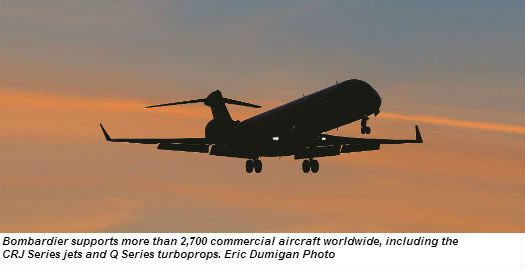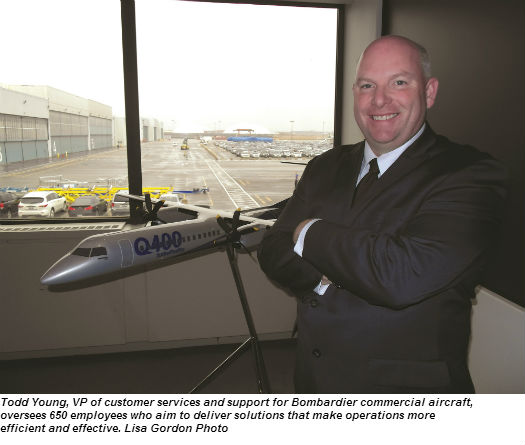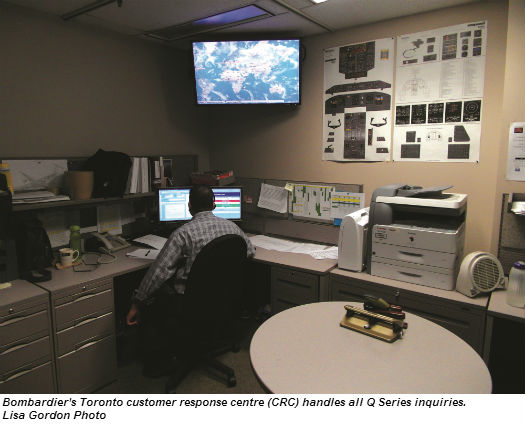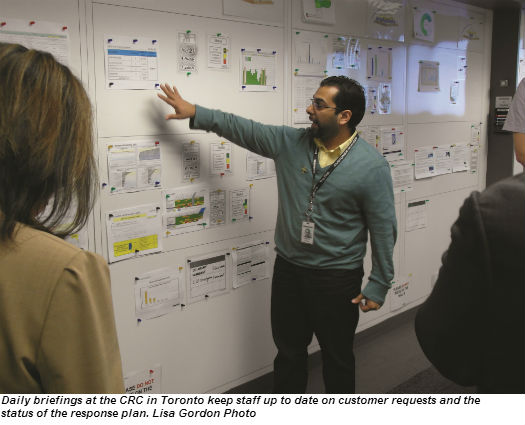With more than 2,700 Bombardier commercial aircraft operating worldwide, Todd Young’s department has a simple mission: keep the aircraft online and keep the customers happy. In this business, the two parts of that mission go hand in hand.
As vice president of customer services and support for Bombardier commercial aircraft, Young oversees about 650 global team members who focus exclusively on providing comprehensive support for two aircraft families: the CRJ Series (out-of-production models 100 and 200, as well as the in-production 700, 900 and 1000); and the Q Series (out-of-production models 100, 200, 300, as well as the in-production Q400).
The CRJ is supported by Bombardier’s customer response centre (CRC) in Mirabel, Que. All Q Series inquiries are handled by the Toronto CRC. When the CSeries enters service in the second half of 2015, it will be supported by a second Mirabel CRC, purpose-built for the new aircraft.
Bombardier’s commercial customer support system is widespread, covering the complete after-market ownership experience, including maintenance, in-service supplier management, customer ops support, business planning and strategy, and technical publications. The team operates on two levels: support personnel react to immediate customer requests, such as those for AOG (aircraft on ground) assistance; while product directors and in-service engineers work proactively to develop new ways of reducing operating expenses.
“Everyone knows the aerospace business is very costly,” said Young. “We are constantly trying to reduce the cost of ownership, and that adds to the value of the product. The initial price of an aircraft is important, but it’s the operating economics over its 20-year life cycle that represents the biggest consideration for airlines.”
As an example, Young pointed out that work performed by the customer support teams have extended the maintenance program intervals on the CRJ 700 and 900, as well as the Q400, during the last couple of years. Those extensions translate into increased value for operators.
DEPLOYING RESOURCES
When Skies visited Young at Bombardier’s Toronto plant, he described the way the OEM’s customer support function has changed over the years. “Twenty years ago, we used to support aircraft through our core engineering groups. We’d do the design as well as supporting the production line, new product development and in-service support. We had a tremendous challenge prioritizing the demands on our time,” said Young.
The solution? Bombardier opted to create a separate “services umbrella,” which encompasses two distinct divisions responsible for servicing commercial and business aircraft. Young’s team deals specifically with the former.
Further changes were made to the aircraft support division in 2007, when Bombardier’s growth led to a realization: the business could no longer be run efficiently from company headquarters.
“Our business was increasing; we were expanding into emerging markets, and we were too far removed from our customers,” said Young. “So, we made a conscious decision to deploy resources into all regions, through the establishment of regional support offices.”
Bombardier’s first regional support office (RSO) for commercial aircraft was established in Tokyo, Japan, in 2007; it was followed closely by offices in Shanghai, China; Sydney, Australia; and Munich, Germany.
“When you look at Japan, China, Australia and Munich, we’ve actually now moved into the time zones that are difficult to service,” commented Young. “Having those offices really improved our ability to service our customers in those regions.”
Today, the company supports its airline customers through a total of eight RSOs, the most recent additions being Singapore; Mumbai, India; Moscow, Russia; and Johannesburg, South Africa. Each location was strategically chosen to allow Bombardier to provide enhanced services to commercial operators of its aircraft platforms. For example, the Mumbai office was opened before the Q400 was delivered to operators in India. “In order to show our customers that they could buy our airplane and have our regional support, we put our foot forward to say, ‘We’re going to be there,’” said Young. He added that Bombardier plans to continue expanding its RSO network, with the focus shifting to the Middle East and South America next.
Each regional support office is staffed by field service representatives, dedicated customer service account managers, liaison pilots and managers. The facilities link customers more directly to Bombardier’s in-service engineering teams and the 24/7 CRCs in Mirabel and Toronto. In addition, the regional locations are also connected to Bombardier’s two main parts distribution hubs in Chicago and Frankfurt, and a wide network of associated regional depots.
To augment the services provided by the RSOs, Bombardier also decided to move some of its core support functions into each region. For example, structures engineers were located in Munich and Sydney, allowing the company to provide 24/7 structures support around the clock.
After implementing its RSO network and adjusting its commercial customer support structure, Bombardier recognized that change was also needed at the highest levels. So, in March 2013, the aircraft manufacturer reorganized its commercial customer support leadership team. Three distinct regions were created: the Americas; Europe, Middle East, Africa, Russia and the CIS; and Asia Pacific. A customer support director was appointed for each region, reporting directly to Young.
“Those three leaders run the regional support offices and they have command and control in their regions,” he explained, adding that after the initial transition pains, the move has paid huge dividends. “In the old organization, if we had a customer in crisis, we’d go and deal with that crisis. The rest of the world would have to wait. But now, those regional directors deal with it, allowing the rest of us to continue focusing on our overall fleet.”
OEM SOLUTIONS
Despite Bombardier’s emphasis on an expanded regional focus and the associated decentralization of decision-making, the CRCs in Mirabel and Toronto remain the nerve centres for the thousands of Bombardier commercial aircraft flying the skies.
Hotline numbers route calls to the proper CRC depending on aircraft type; from there, an inquiry is directed to the technical help desk (THD) where front-line support personnel respond to a good portion of the calls directly. In cases where specialist knowledge is required, the THD brings in aircraft systems or structure experts. Each CRC employs engineers with both formal and on-the-job experience with Bombardier aircraft, as well as authorized individuals who may sign off aircraft repairs on behalf of the major aviation authorities.
Sometimes, Bombardier will dispatch engineers to assist with bringing an AOG aircraft back online. An onsite response could take the form of one technical support engineer, or an entire mobile repair team (MRT). The MRTs are capable of performing extensive physical repairs, including major work such as complete cockpit replacement, removing and replacing a wing, and skin replacements. “It’s actually a very good feature we offer our customers,” said Young. “Getting the OEM solution continues to add value to that airplane over its lifetime.”
Often, mobile personnel are called out with little warning. Last New Year’s Eve, an operator in Papua New Guinea incurred structural damage to an aircraft, requiring immediate assistance to return it to service. A structural engineer based in Sydney put his holiday on hold, immediately flying out to assist with the repair. Timing was critical, and the aircraft was turned around quickly.
In another instance, an operator was identified as performing at a fleet optimization level below the worldwide average. Bombardier sent out a team to work with them for a week, creating a three-phase plan to drive improvement.
“That’s another way we help our airlines, by lending our brain power to them to help them become more efficient,” said Young. “Sometimes it’s one person who goes to a customer, and sometimes it’s a whole team.”
LOOKING AHEAD
Young said the expansion of Bombardier’s regional support network has been driven by two priorities: the need to be on the ground in key emerging markets; and the desire to differentiate the company from its competitors. In response to those priorities, Bombardier developed its “global presence roadmap” back in 2007, a plan it’s been following ever since.
The future holds more of the same: a continued expansion of Bombardier’s global presence, expanded capacity and capability of regional offices, growth into developing regions, and getting closer to customers—reaching out both personally and digitally.
“We hold a regular schedule of regional reviews. We take our teams out into the regions and hold a mini-con-ference, where we connect with more people within the airlines,” explained Young, who travels more than nine months of the year. “We’re spending more time face-to-face with our customers; that’s our future direction. Our operators like us to be at their businesses; they feel we’re in partnership with them.”
Technology also plays a big part in Bombardier’s overall customer support plan, although Young admits there are challenges in that department. “Technology is changing so fast, and many emerging markets don’t have the connectivity we’re used to in North America,” he explained. So, even though the department’s website, iflybombardier.com— which logged about 600,000 visits in 2013—features a number of online tools and solutions for commercial operators, not every customer can take advantage of them.
That’s when a Plan B is needed. For example, when Thailand’s Nok Air signed on to purchase a pair of Q400s last fall, with options since filled for two more, Young tasked the Toronto CRC with evaluating computation times in Thailand. As a result, the team developed an online resource program tailored to the connectivity capabilities of Nok Air.
“Our goal is to listen to our customers, and understand their needs,” said Young. “What may have been great yesterday is no longer great today. So, being flexible and adaptable in how we offer our services, and what services we offer, is critically important.”
When operators consider purchasing Bombardier commercial aircraft, the company’s customer support network is an important part of the value proposition.
“We are there to support our airplanes,” emphasized Young. “One of the interesting facts that is becoming more and more apparent today, as the aerospace business changes, is that operators are relying heavily on the support offering that comes along with the aircraft. We’re one of the reasons they buy Bombardier – they get solutions to make their airline more efficient and effective, at a cost that is affordable for them.”







